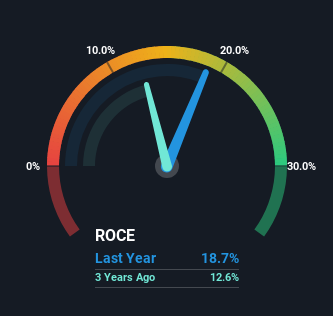- United Kingdom
- /
- Household Products
- /
- LSE:RKT
Reckitt Benckiser Group (LON:RKT) Is Looking To Continue Growing Its Returns On Capital

If you're looking for a multi-bagger, there's a few things to keep an eye out for. Typically, we'll want to notice a trend of growing return on capital employed (ROCE) and alongside that, an expanding base of capital employed. Put simply, these types of businesses are compounding machines, meaning they are continually reinvesting their earnings at ever-higher rates of return. So when we looked at Reckitt Benckiser Group (LON:RKT) and its trend of ROCE, we really liked what we saw.
Return On Capital Employed (ROCE): What Is It?
If you haven't worked with ROCE before, it measures the 'return' (pre-tax profit) a company generates from capital employed in its business. The formula for this calculation on Reckitt Benckiser Group is:
Return on Capital Employed = Earnings Before Interest and Tax (EBIT) ÷ (Total Assets - Current Liabilities)
0.19 = UK£3.4b ÷ (UK£28b - UK£9.3b) (Based on the trailing twelve months to June 2023).
Thus, Reckitt Benckiser Group has an ROCE of 19%. In absolute terms, that's a satisfactory return, but compared to the Household Products industry average of 9.8% it's much better.
View our latest analysis for Reckitt Benckiser Group

In the above chart we have measured Reckitt Benckiser Group's prior ROCE against its prior performance, but the future is arguably more important. If you're interested, you can view the analysts predictions in our free report on analyst forecasts for the company.
What Can We Tell From Reckitt Benckiser Group's ROCE Trend?
You'd find it hard not to be impressed with the ROCE trend at Reckitt Benckiser Group. The data shows that returns on capital have increased by 66% over the trailing five years. That's a very favorable trend because this means that the company is earning more per dollar of capital that's being employed. In regards to capital employed, Reckitt Benckiser Group appears to been achieving more with less, since the business is using 38% less capital to run its operation. Reckitt Benckiser Group may be selling some assets so it's worth investigating if the business has plans for future investments to increase returns further still.
For the record though, there was a noticeable increase in the company's current liabilities over the period, so we would attribute some of the ROCE growth to that. Essentially the business now has suppliers or short-term creditors funding about 34% of its operations, which isn't ideal. Keep an eye out for future increases because when the ratio of current liabilities to total assets gets particularly high, this can introduce some new risks for the business.
What We Can Learn From Reckitt Benckiser Group's ROCE
In a nutshell, we're pleased to see that Reckitt Benckiser Group has been able to generate higher returns from less capital. Considering the stock has delivered 4.0% to its stockholders over the last five years, it may be fair to think that investors aren't fully aware of the promising trends yet. So with that in mind, we think the stock deserves further research.
One more thing, we've spotted 2 warning signs facing Reckitt Benckiser Group that you might find interesting.
If you want to search for solid companies with great earnings, check out this free list of companies with good balance sheets and impressive returns on equity.
New: AI Stock Screener & Alerts
Our new AI Stock Screener scans the market every day to uncover opportunities.
• Dividend Powerhouses (3%+ Yield)
• Undervalued Small Caps with Insider Buying
• High growth Tech and AI Companies
Or build your own from over 50 metrics.
Have feedback on this article? Concerned about the content? Get in touch with us directly. Alternatively, email editorial-team (at) simplywallst.com.
This article by Simply Wall St is general in nature. We provide commentary based on historical data and analyst forecasts only using an unbiased methodology and our articles are not intended to be financial advice. It does not constitute a recommendation to buy or sell any stock, and does not take account of your objectives, or your financial situation. We aim to bring you long-term focused analysis driven by fundamental data. Note that our analysis may not factor in the latest price-sensitive company announcements or qualitative material. Simply Wall St has no position in any stocks mentioned.
About LSE:RKT
Reckitt Benckiser Group
Manufactures and sells health, hygiene, and nutrition products worldwide.
Average dividend payer and fair value.

